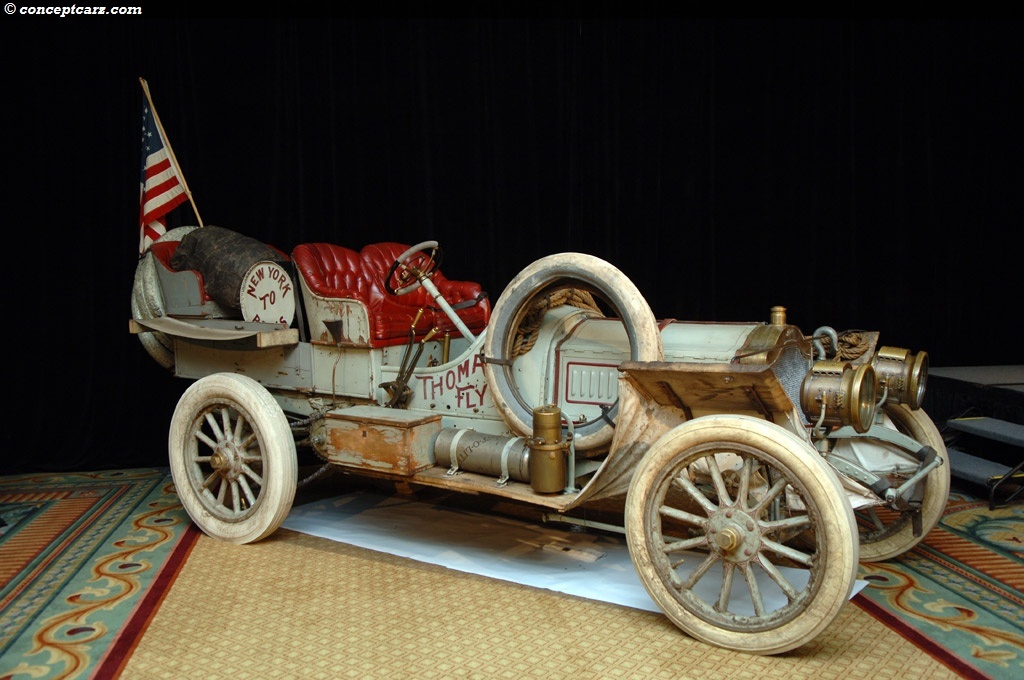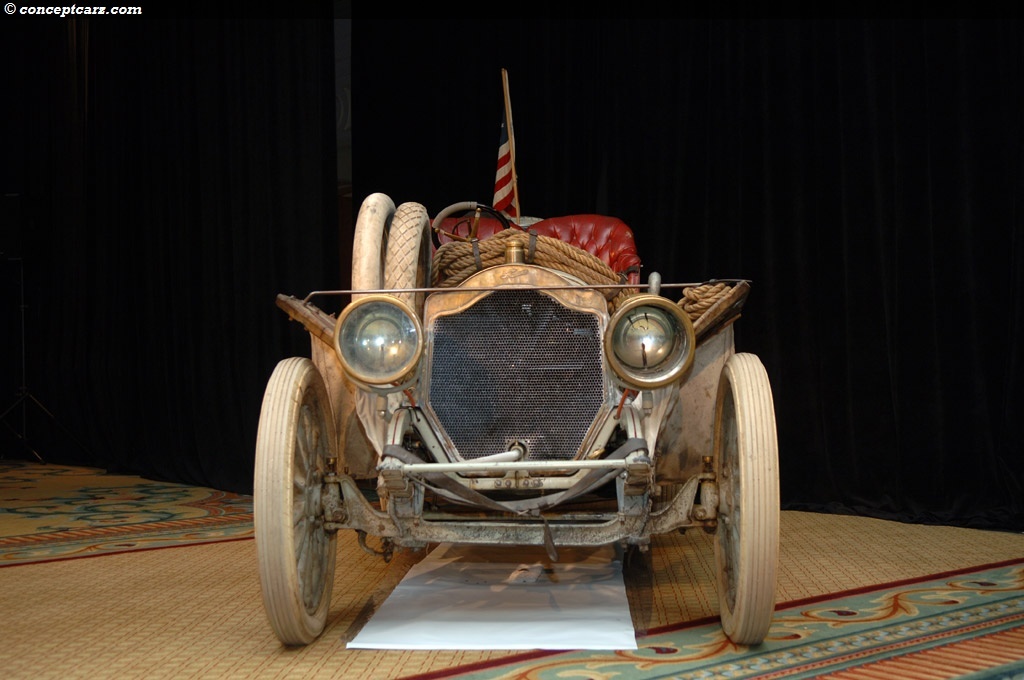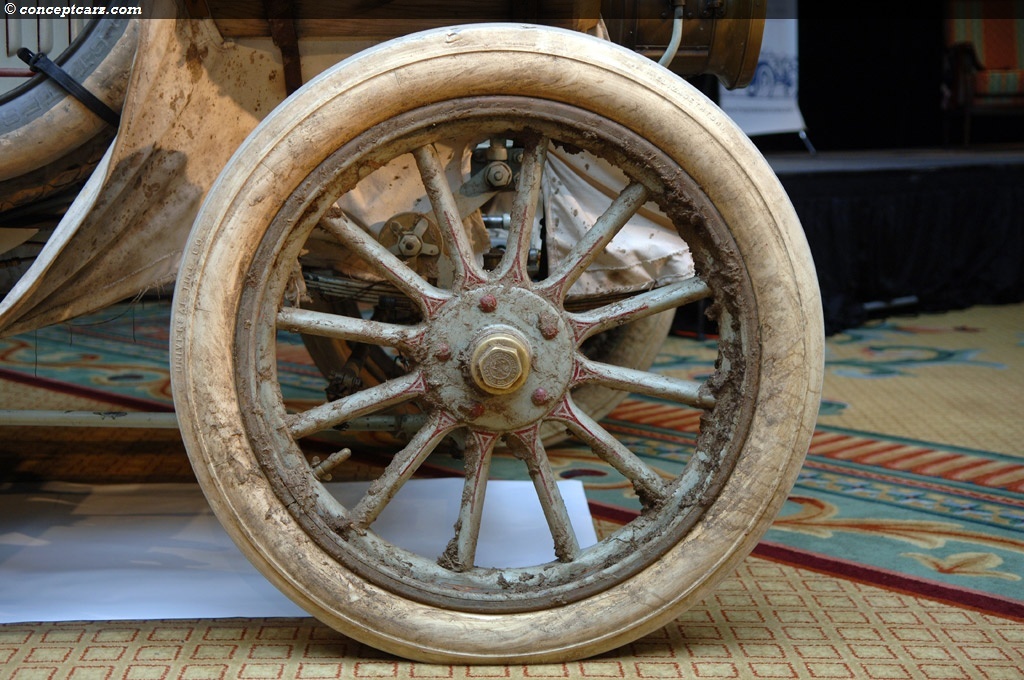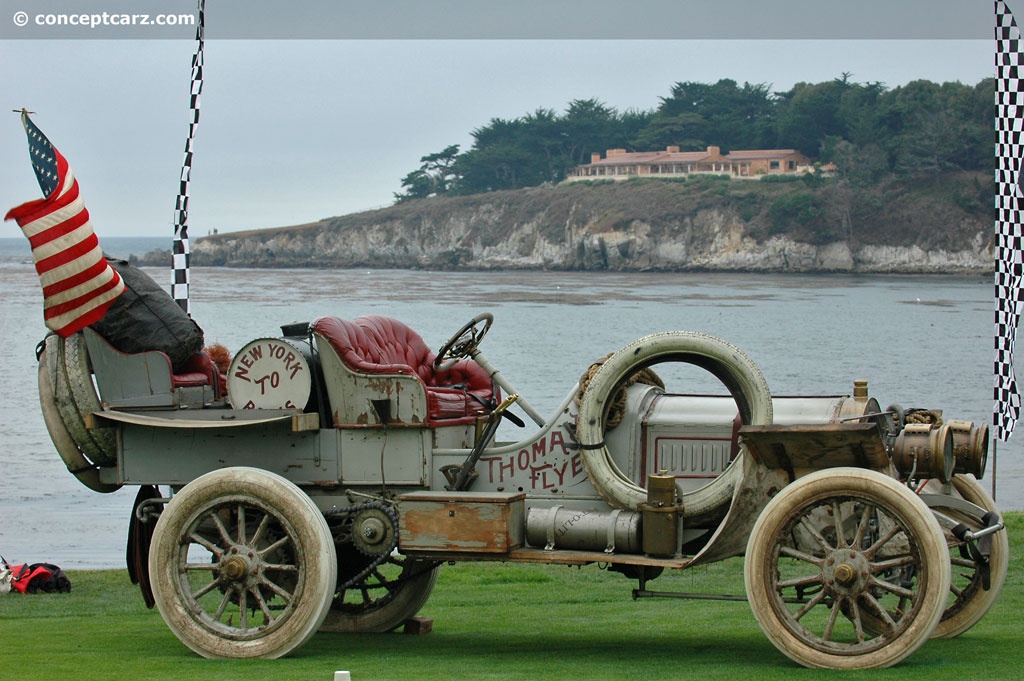1907 Thomas Flyer Model 35 Navigation
During the early 20th century, many automobile builders believed that a good finish at the local track on Sunday meant strong sales on Monday. This was proven true on many occasions. Racing became a way of promoting and proving a product. One of the most daring and adventurous races was the Great Race, an event that took competitors around the world, running across four continents and through the Bering Straits during winter. An important point to remember is that during this early era of the automobile, there were very few roads; the ones that did exist were far from the standards of today. 
Touring
View info and historyThere was only one running of the Great Race, and it took place in 1908. E.R. Thomas's vehicle was a last-minute entry and was basically a stock Model 35 Thomas Flyer powered by a four-cylinder engine that produced 70 horsepower. Over three days time, the car was given a larger fuel tank, spare tires, and running boards, which could be used for traction when the vehicle got stuck. The race was sponsored by The New York Times and the Paris-based La Matin paper. The Thomas Flyer represented the United States; other countries included France, Italy, and Germany totaling seven teams.Nearly 250,000 people came to watch the cars start the race at Times Square on February 12th, 1908. The teams traversed the US continent during the middle of winter, with the Thomas reaching San Francisco first. Prior to reaching the west coast, key members of the team were replaced, leaving George Schuster, Hans Hendrick Hansen, and NY Times Correspondent George MacAdam. 
Touring
View info and historyThe Thomas Flyer was loaded on a ship that brought it to Valdez, Alaska. This was a historic accomplishment as it was the first car ever in Alaska. Its stay in Alaska was brief, as the route was judged too difficult and treacherous, so it was loaded back onto a ship and brought to Japan. Its journey continued through Russia and continued westward. Again, the roads that did exist were often difficult to travel. When roads did not exist, the teams were forced to make their own route. Getting stuck was not uncommon as Mother Nature provided plenty of mud and snow. When mechanical failures occurred, the teams were forced to find creative methods to patch and repair the problem. There was little sleep to be had, especially while traveling through Russia near the Trans-Siberian Railway, which was not a friendly place at the time. The Thomas Flyer completed the entire distance in 169 days. They were not the first to cross the finish line though; the German team had beaten them but were later penalized for bypassing the Alaskan part of the trip and for using trains for transportation. This left the U.S. team in first place. The next team to arrive in Paris did so 26 days later.
Touring
View info and historyHaving traveled around the world and winning the one-and-only Great Race, the public was guaranteed a strong and reliable product. Sales of the Thomas Flyers increased over the next few years, but their success would be short-lived. In 1911, the company only produced six-cylinder cars. Within a year, the car had entered into receivership and was purchased by C.A. Finnegan of the Empire Smelting Company. The company continued to produce cars through 1916, after which the cars were able to be special ordered. It is believed that the company continued until 1918 or 1919.George Schuster was the only individual to travel the entire 22,000-mile race. With his help, the winning car was later restored to its original trim in nearly the exact condition in which it had entered Paris.
by Daniel Vaughan | Sep 2008

Touring
View info and history

Touring
View info and history

Touring
View info and history
by Daniel Vaughan | Sep 2008
The Thomas Flyer automobile that won the historic New York-to-Paris 'Great Race' in 1908 will come to the Florida coast for the 13th annual Amelia Island Concours d'Elegance, March 7-9, 2008. Contested 100 years ago, the torturous race covered the width of the United States before stopping at points in Alaska, Japan, Siberia, and Berlin before ending in Paris. It has never been run again.
Touring
View info and historyWith the automobile barely a decade old, the thought of an around-the-globe race was unheard of at the time, but also very tempting to the adventurers of the day. The New York-to-Paris race turned out to be much more than a race; it was about national pride and the quest for automotive superiority among the leading 'modernized' countries of the era. Sponsored by The New York Times and the Paris-based La Matin paper, teams from France (Motobloc, DeDion, Sizaire-Naudin), Italy (Zust), Germany (Protos), and the United States (Thomas) were entered in the grueling challenge. Nearly 250,000 people were on hand on February 12, 1908, to cheer the cars as they started from Times Square. The winning Thomas Flyer covered 22,000 miles in 169 days, a record that still stands today.'To have the National Automobile Museum, The Harrah Collection, in Reno, Nevada, loan us this national treasure during their 100th anniversary is more than words can express,' says Bill Warner, founder and co-chairman of the Amelia Island Concours d'Elegance. 'It will be a once-in-a-lifetime experience for the attendees to see this car up close and personal. All will be amazed at the primitive nature of the car and what it went through.'Famed collector William Harrah found the Thomas Flyer in the early Sixties and, with the help of George Schuster, the only member of the U.S. team to drive the entire 22,000-mile race, he painstakingly brought the vehicle back to its original trim just as it entered Paris in 1908. Weighing in at 4,000 pounds fully loaded, the Thomas Flyer's four-cylinder power plant could propel it to 60 mph. The car finished 26 days ahead of the second-place German-entered Protos.Special Seminar Will Recount The Thomas Flyer's Adventure
Touring
View info and historyOn Friday, March 7th, Amelia's annual seminar series will kick off with a presentation by Jeff Mahl, great grandson of George Schuster. With the original 1907 Thomas Flyer that won the race being at the show and in the Ritz-Carlton's grand ballroom for the presentation, Mahl will be reliving the events of that epic race with original photos and a first-person account of this international competition which reshaped automotive history. The race is considered by many to have ushered in the era of the automobile as viable transportation.The 2008 Amelia Island Concours d'Elegance will be held March 7-9 on the 10th and 18th fairways of The Golf Club of Amelia Island at Summer Beach adjacent to The Ritz-Carlton, Amelia Island. Parnelli Jones is the honoree and the cars of the E.R. Thomas Motor Car Co. will be featured. The show's Foundation has donated nearly $1.5 million to Community Hospice of Northeast Florida, Inc. since 1996.Source - Amelia Island Concours

Touring
View info and history

Touring
View info and history
The Erwin Ross (E.R.) Thomas Motor Company produced automobiles from 1902 through 1919. Production transpired in Buffalo, New York. The first cars produced by the company appeared in 1903 and were mostly small runabouts with seating for two. The company had begun like so many other auto-manufacturing firms at the time - through a bicycle business. Thomas had been building bicycles for several companies before making the switch to automotive production. 
Touring
View info and historyThe first E.R. Thomas Motor cars were powered by a vertically-mounted water-cooled straight-three cylinder engine that produced just over 20 horsepower. The engine was mated to a two-speed planetary gearbox. As times progressed, so did the E.R. Thomas Motor Cars. The Company did much to promote its vehicles and to attract customers, such as painting the cars in bright and attractive colors. The cars became more powerful and elegant and became renowned for their reliability and endurance. In 1908, an E.R. Thomas Car was entered into 'The Great Race', which ran from New York to Paris. The decision was made at the last minute, and there was little time to properly adapt the car for the race. Instead, the company pulled one from the production line and entered it into the race. The race began in New York during the winter and proceeded to San Francisco. The entrants then loaded onto a boat and traveled to Alaska and then Siberia. Once they arrived in Siberia, the race continued. 
Touring
View info and historyThe race lasted 171 days and covered 13,300 miles. At the conclusion of the race, ending in Paris, it was an E.R. Thomas in first place, claiming the overall victory. Demand for the E.R. Thomas Motor cars increased after the heroic victory. In 1911, the company only produced six-cylinder cars. Within a year, the car had entered into receivership and was purchased by C.A. Finnegan of the Empire Smelting Company. The company continued to produce cars through 1916, after which the cars were able to be special ordered. It is believed that the company continued until 1918 or 1919.
by Daniel Vaughan | Mar 2008

Touring
View info and history

Touring
View info and history
by Daniel Vaughan | Mar 2008
- 1907 Thomas Flyer Model 35 Menu
- Article
- Image gallery
- Specifications
Thomas
Similar Vehicles
Similarly Priced Vehicles
1907 Thomas Flyer Model 35 Vehicle Profiles
Recent Vehicle Additions
Performance and Specification Comparison
Price Comparison
Related Automotive News

Past Best of Show Winners at The Pebble Beach Concours d'Elegance
overview1
The 70th anniversary of the Pebble Beach Concours dElegance was celebrated with a spectacular display of previous Best of Show winners. Thirty-seven examples graced the showfield and many were still with the same owners who raised the trophy...

ALL-ORIGINAL FERRARI 365 GTB/4 DAYTONA TO BE OFFERED BY ITS FIRST AND ONLY OWNER AT RM'S AMELIA ISLAND SALE
RM Auctions presents the Condo Find Daytona at its Amelia Island, Florida sale, March 14
Offered on behalf of its original owner, the Ferrari 365 GTB4 Daytona recently emerged from 25 years storage in downtown Toronto
The official auction of...

Horch 853 And Scarab Win The 19Th Annual Amelia Island Concours D'Elegance
Nearly 29,000 Automotive Enthusiasts and More Than 325 Automobiles Attend The Worlds Most Innovative Concours Weekend
Jacksonville, FL (March 11, 2014) – A 1937 Horch 853 and 1958 Scarab won the Best In Show honors on Sunday, March 9,...

OFFENHAUSER HEROES AND MERCHANTS OF SPEED SEMINARS OFFER FANS A BACKSTAGE PASS TO AMERICAN MOTORSPORT
A pair ofthe Amelia Island Concours dElegances popular seminars will offer backstage passes to the history and the business of American motorsport.
On Friday March 7, 2014 the celebration of Offenhauser-powered vehicles will begin in the Talbot...
New York-to-Paris-Winning Thomas Flyer coming to Amelia for 100th Anniversary of its Historic Victory
The Thomas Flyer automobile that won the historic New York-to-Paris Great Race in 1908 will come to the Florida coast for the 13th annual Amelia Island Concours dElegance, March 7-9, 2008. Contested 100 years ago, the torturous race covered the width...


































